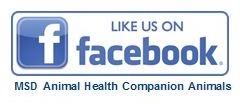
DISEASE INFO
Feline Viral Upper Respiratory Tract Disease
Feline viral upper respiratory tract disease is typified by signs of rhinosinusitis, conjunctivitis, lacrimation, salivation, and/or oral ulcerations. The principal causative agents are feline herpesvirus type 1 (FHV-1 ) and feline calicivirus (FCV). These viruses are host-specific and pose no known human risk. Other infectious agents (e.g. Bordetella bronchiseptica, mycoplasma spp., reoviruses) can also be involved in causing similar signs of respiratory disease, but it is believed that around 80% of cases are caused by either FHV-1, FCV or a dual infection with both agents.
FCV
Etiology and Pathogenesis
FCV is a small single-stranded RNA virus which is susceptible to most common disinfectants. It is relatively resistant to environmental conditions and can potentially survive up to a month in the environment, although in most cases probably does not survive more than 7-14 days. A feature of
FCV is that it readily mutates during replication resulting in many different strains of the virus which exist in the field, some of which are more pathogenic than others.
FCV is shed via oral and nasal secretions during acute disease. Following clinical recovery, most cats continue to shed the virus for at least a month and a few continue to shed for several years.
Feline calicivirus infection is widespread in the general cat population. The prevalence of infection is broadly proportional to the number of cats in the household, ranging from 10% for household pets kept in small groups up to 40% in some large colonies. Transmission of infection is most commonly via direct contact with saliva, ocular or nasal secretions or inhalation of aerosols. However, since the virus can easily survive for some time in the environment, transmission is also possible via infected fomites such as food bowls, litter trays, bedding and grooming equipment.
Following infection via the nasal, oral or conjunctival route a transient viraemia occurs 3 to 4 days later and the virus can then be detected in many other tissues. Typically FCV induces signs of upper respiratory tract disease and lingual ulceration. However FCV can also cause other manifestations of disease such as lameness, due to acute synovitis and, more recently, certain strains of FCV have been shown to cause a much more severe, potentially fatal systemic condition involving widespread vasculitis with multiorgan involvement referred to as virulent systemic disease.
Clinical and Pathological Findings
Clinical signs vary depending on factors such as strain virulence and the age of the affected cat. In some cases infection is subclinical, however in many others, following an incubation period of 2-10 days, there are typical signs of lingual erosions (resulting in hypersalivation), sneezing and serous nasal discharge accompanied by fever and anorexia. More severe cases can occur, particularly in young kittens, with signs of dyspnoea, coughing, fever and depression.
FCV can be isolated from nearly all cats with chronic gingivo-stomatitis. However the disease has not been reproduced using isolates from clinical cases and it has been suggested that the condition represents some sort of immune-mediated reaction to FCV and possibly other oral antigens.
Occasionally, particularly in young cats, FCV infection can result in signs of lameness due to acute arthritis (synovitis). This is a transient problem, usually only lasting a few days and there will often, be signs of respiratory disease at the same time.
Rarely, outbreaks of a much more serious systemic disease have been associated with particular strains of FCV, referred to as ‘virulent systemic strains. Infection with these strains can result in severe pneumonia, hepatitis, pancreatitis, skin swelling and ulceration, and bleeding from the nose and intestine. In these outbreaks up to 50% of affected cats can die.
FHV-1
Etiology and Pathogenesis
FHV-1 is an enveloped double-stranded DNA virus which is readily inactivated by most commercially available disinfectants, antiseptics and detergents. It is relatively fragile and probably only survives for 1-2 days in the environment. It exists as a single serotype although virulence can vary between different isolates.
FHV-1 is shed via oral, nasal and ocular secretions in clinically affected cats. Viral excretion starts as soon as 24 hours after infection and lasts for 1 to 3 weeks. After infection, virtually all cats will remain latently infected, becoming life-long carriers of the virus. Some of these cats will intermittently shed virus again, commonly following episodes of stress or immunosuppression. Along with reactivation of shedding, some cats will also develop a recrudescence of clinical signs.
The prevalence of viral shedding ranges from less than 1% in households with small numbers of healthy individuals to 20% amongst large groups, especially where clinical disease is present. The true prevalence of infection will of course be much higher due to latently infected cats not shedding virus at the time of sampling. Transmission of infection is largely via direct contact with saliva, ocular or nasal secretions or inhalation of aerosols.
The virus infects via the nasal, oral or conjunctival routes. During infection, the virus spreads along the sensory nerves and reaches neurons, particularly in the trigeminal ganglia, which are the main sites of latency.
Clinical and Pathological Findings
Acute upper respiratory tract disease is the most common manifestation of FHV infection. The respiratory signs caused by FHV-1 are often broadly similar but generally more severe than those caused by FCV. Typical signs include conjunctivitis, ocular discharge, sneezing, nasal discharge, salivation, pharyngitis, lethargy, fever, anorexia and sometimes coughing. These signs can last from a few days to a few weeks.
A less common manifestation of chronic FHV infection is conjunctivitis and keratitis. FHV infection causes the development of multiple small branching corneal ulcers (called ‘dendritic keratitis’) which is considered diagnostic of FHV infection. Rarely, chronic FHV infection can result in skin inflammation and ulceration. This is most commonly seen around the nose and mouth, but can affect other areas such as the front legs.
Diagnosis
In most cases, a specific diagnosis of FCV or FHV-1 infection will not be required. The presence of typical upper respiratory signs is enough for a presumptive diagnosis of FCV and/or FHV-1 infection. Signs of oral ulceration and milder respiratory signs tend to suggest the involvement of FCV whereas more severe respiratory illness and signs of keratitis in may suggest the involvement of FHV-1. If a specific diagnosis is required, ocular or oral swabs can be submitted for viral culture or, more commonly nowadays, PCR detection. The detection of virus in skin biopsies and can be useful for the diagnosis of FHV-associated dermatitis.
Source: Merck Vet Manual

Canine Cough, or canine infectious tracheobronchitis, is a highly contagious respiratory disease in dogs. Found worldwide, the disease will affect a relatively high percentage of dogs in their lifetime. Learn how you can do your part to protect against Canine Cough and keep bonds strong.
Rabies causes over 55,000 deaths in people each year in Africa and India. Learn how you can help eliminate this deadly disease by protecting your pet with Nobivac vaccines.
Create stronger bonds by educating yourself on the importance of vaccinating your pets. Keep informed about the benefits of vaccination with our helpful animation.
Equine influenza is a highly infectious respiratory disease of horses. Found almost worldwide, the disease will affect a worrying percentage of horses in their lifetime. Learn how you can do your part to protect against Equine influenza and keep the bonds strong.






